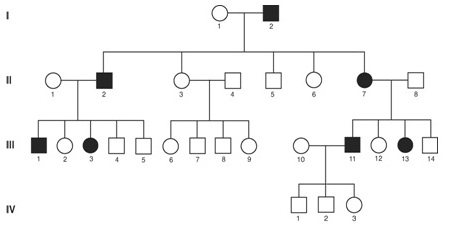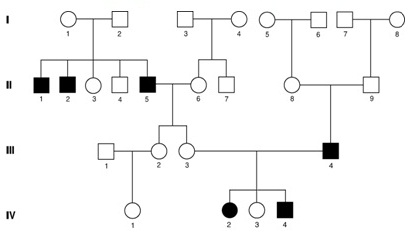Answer the questions in your own words, using full sentences where applicable.
For each of questions 15, select the most suitable response, and describe your choice.
1. Mitochondrial inheritance is
a. maternal.
b. sex-limited.
c. sex-influenced.
d. genomic.
e. rare.
Describe.
2. Individual who has ____________ is male.
a. development of the Müllerian ducts
b. an MSY region
c. an SRY gene and no testes
d. indifferent gonads
e. degradation of the Wolffian ducts
Describe.
3. A normal female human is expected to have
a. a mosaic phenotype.
b. X-inactivation of both X chromosomes in a somatic cell.
c. traits associated with the SRY transcription factor.
d. one Barr body in each somatic cell.
e. two of the above.
Describe.
4. Which of the embryo possibilities explained below will most probable result in repeated miscarriages?
a. heterozygous for a lethal allele
b. homoplasmy for a normal allele
c. homozygous for lethal alleles
d. lack of penetrance for a lethal allele
e. heteroplasmy
Describe.
5. Genomic imprinting is an example of
a. heterogeneity.
b. epistasis.
c. pleiotropy.
d. an epigenetic effect.
e. a phenocopy.
Explain.
6. Match each descriptor or example in right-hand column to the best term in left-hand column. Utilize only one descriptor per term and one term per descriptor.
Term Descriptor/example
1. ____ linkage disequilibrium a. refers to male mammals
2. ____ sex-limited trait b. inherited together
3. ____ heterogametic c. difference in expression due to internal environment
4. ____ heritability d. caused by restrictions to crossing over
5. ____ hemizygous e. additive effects of two or more genes
6. ____ haplotype f. dosage compensation
7. ____ sex-influenced trait g. discrete expression
8. ____ polygenic h. males expressing an X-linked recessive trait
9. ____ qualitative trait i. testicular cancer
10. ____ X-inactivation j. variation in phenotype due to genetic variation
7. Organism has 16 chromosomes in its somatic cells. Find out number of gametes with different chromosome compositions that it could potentially create. Describe your answer. Ignore allelic variation created by crossing over.
8. In the following pedigrees, the disorders or traits presented follow simple patterns of Mendelian inheritance. For each trait, Find out the most likely mode of inheritance, stating whether the trait is due to autosomal or X-linked gene, and a dominant or recessive allele. In each case, indicate and describe the evidence for each pattern, giving at least one statement and example from the pedigree to defend each part of your analysis. Then, giving a legend for your symbols, assign genotypes to the specified individuals.
a. Give genotypes for individuals II-5, III-6, III-11.

b. Give genotypes for individuals I-5, II-5, III-3, IV-3.

9. Achondroplasia is an autosomal dominant disorder associated with a gene on chromosome 4. Sickle cell anemia is due to a gene on chromosome 11. A man and a woman with achondroplasia, who each had a normal parent, are carriers for sickle cell anemia.
a. Give genotypes of these individuals; provide a legend for your symbols.
b. Construct a Punnett square to find the possible types of offspring these two people can have together.
c. Summarize the Punnett square to list the genotypes and their ratio.
d. Name the likely phenotypes and the expected proportions of these phenotypes.
e. What is the name for this type of cross?
f. If these genes had been on the same chromosome, will you expect the similar results for potential offspring? Why or why not?
10. A woman is heterozygous for three X-linked loci: AaBbDd. She has seven sons with following genotypes:
two are X ABd Y
three are X abD Y
one is X ABD Y
one is X Abd Y
a. What is the most probable combination of alleles on each of the mother’s X chromosomes?
b. Which of the seven sons is/are the result of recombination? Between which genes did the crossover occur in the mother’s oocyte to create each recombinant X?
c. Name the other possible recombinant genotypes which have not appeared in these sons.
11. Based on the simplified two-gene model for eye colour, describe using genotypes how two blue-eyed parents could produce a brown-eyed child.
12. In what ways is genomic imprinting same as X-inactivation? In what ways is it different?
13. In a twin study of 1000 MZ pairs, 625 pairs were found to have both twins with the same form of a given trait. In a study of 1000 DZ twins, 426 pairs were found to have both twins with the same form of that trait.
a. What parameter could be computed from this data?
b. Compute it for MZ twins and DZ twins, showing your calculations.
c. What does this parameter informs us about this trait?